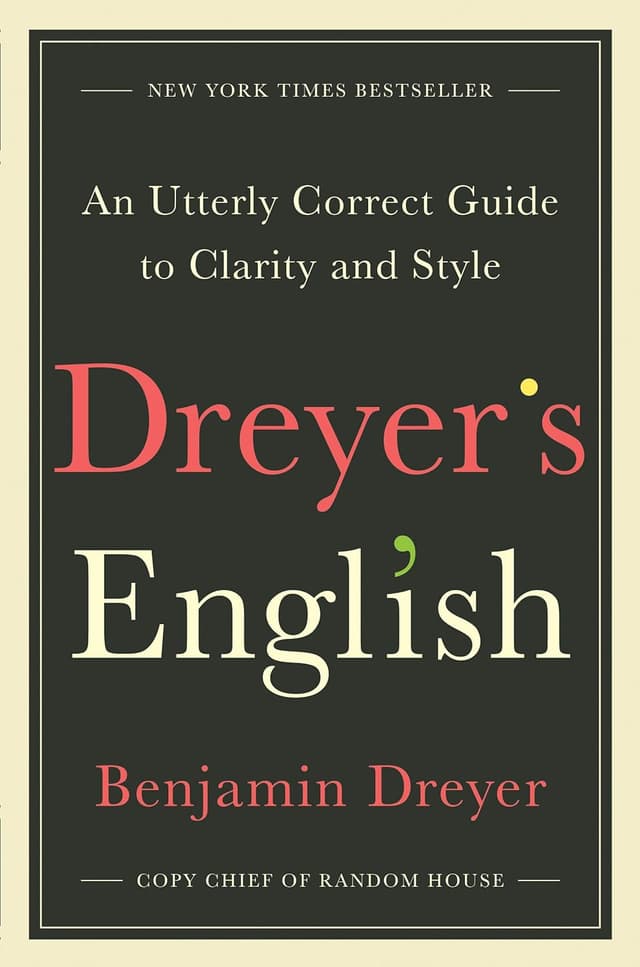Noah Brier | April 1, 2019
Why is this interesting? - Monday, April 1
On prison, crime, and society
Recommended Products

A writing guide by the copy chief of Random House.
Warning: Today’s top section isn’t a lot of fun. It’s about prisons and how awful they are and includes a bit of graphic language from a New York Times story. I thought about moving it to not Monday, but as this is an email featuring interesting things we are reading at the moment, I thought it was best to keep it for this morning. - Noah (NRB)
A few weeks ago the New York Times received thousands of photos they believe were taken inside the St. Clair Correctional Facility in Alabama. The photos detailed the sort of horrific events we frequently see dramatized in TV shows and movies, with homemade knives, dead bodies, and lots of blood: “In puddles. In toilets. Scrawled on the wall in desperate messages. Bloody scalps, bloody footprints, blood streaming down a cheek like tears.” Ultimately the Times decided they couldn’t run the images both for reasons of prisoner privacy and lack of context (they can’t completely confirm the prison they were taken), but they could, and should, describe what they saw.
Why is this interesting?
“Prisons,” as Times criminal justice editor Shaila Dewan writes “are the black boxes of our society. With their vast complexes and razor wire barriers, everyone knows where they are, but few know what goes on inside.”
I am far from deeply knowledgeable about the topic, but it’s been on my mind since reading a 2012 n+1 piece by Christopher Glazek titled Raise the Crime Rate. That article is almost definitely the most affecting I’ve read in the last ten years. The argument, essentially, is that the way we’ve lowered crime in America is to legalize it in prison.
“America’s prison system is a moral catastrophe. The eerie sense of security that prevails on the streets of lower Manhattan obscures, and depends upon, a system of state-sponsored suffering as vicious and widespread as any in human history. Dismantling the system of American gulags, and holding accountable those responsible for their operation, presents the most urgent humanitarian imperative of our time.”
All of it harkens back to science fiction writer Ursula le Guin’s short story The Ones who Walk Away from Omelas. In it she asks what price we’re willing to pay for happiness.
“They all know it is there, all the people of Omelas. Some of them have come to see it, others are content merely to know it is there. They all know that it has to be there. Some of them understand why, and some do not, but they all understand that their happiness, the beauty of their city, the tenderness of their friendships, the health of their children, the wisdom of their scholars, the skill of their makers, even the abundance of their harvest and the kindly weathers of their skies, depend wholly on this child’s abominable misery.”
That’s from 1973. Things have only gotten worse. (NRB)
Quick Links:
Big news for styleguide nerds: The AP announced journalists could now use the % symbol instead of writing out the word percent. This is one of the few things that really stuck with me from my six months as a professional journalist. The best reaction I saw came from Adam Isserlis on Twitter: “I always got such smug satisfaction when removing someone's % and adding in "percent" in a doc. Where am I supposed to get that feeling now!?!?!?” (NRB)
We’ve tried to steer clear of politics on here, but this Chris Hayes podcast episode with psychiatrist and sociologist Jonathan Metzl is worth a listen (thanks for the tip Greg). It’s all about how policies are shortening the lives white people. I won’t dive in too much, because there’s a lot there, but this one statistic about gun suicide versus overdose suicide really struck me: “gun is lethal 96 percent of the time. Whereas overdose, which is the most common global way to attempt suicide, it's lethal about three to four percent of the time.” (NRB)
A journey through the Atacama desert (CJN)
A smart inside read for people who want to learn more on the ground details from Saudi. Written by Ahmed Al Omran (CJN)
Apparently every year the National Guard drops 10,000 Christmas trees into New Orleans wetlands to help combat rising sea levels. “The trees also create a stable platform on which new plants can grow, and by slowing waves and trapping silt, they help keep the water clear. This allows more sunlight to reach submerged vegetation, which in turn helps the waterfoul that nosh on these plants.” (NRB)
New York’s most underrated restaurants according to 14 chefs. (CJN)
This animated graphic explainer from the NYT on what went wrong with the 737 MAX is by far the best explanation I’ve seen. (NRB)
Interesting interview with a business hero of mine, Brunello Cucinelli (CJN)
I keep hearing about Dreyer’s English, a writing guide by the copy chief of Random House. I’ve got it on the list. (NRB)
If you have any interest in F1 at all I would check out the Netflix series Drive to Survive. It tracks a bunch of teams fighting for third, fourth, and fifth place and paints an interesting picture of one of the world’s most expensive sports. I enjoyed it enough that I watched my first F1 race this weekend and understood just enough to enjoy myself. (NRB)
Thanks for reading,
Noah (NRB) & Colin (CJN)